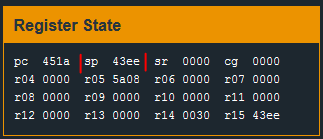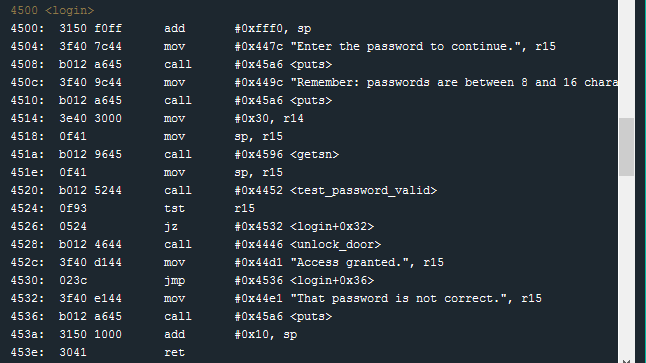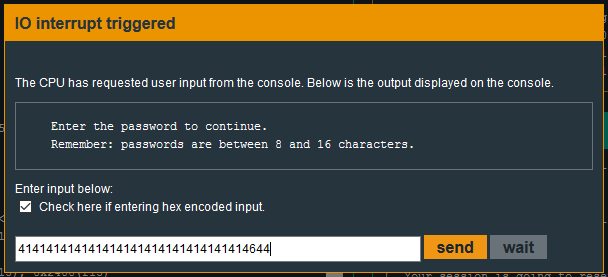Micro Corruption - 04 - Cusco
by
We are now on Lockitall LockIT Pro, revision b.02
What changed in this edition?
“We have fixed issues with passwords which may be too long”
Click here to read about cracking Level 3 - Hanoi.
Level 4 - Cusco
In reviewing the login function in the Disassembly window, I can see that the cmp.b operation from revision b.01 has been removed. And, even though the overview mentions corrected issues with passwords which may be too long, I can immediately see this has not been fixed at all.
At 0x4514 the length parameter for this getsn function is passed to r14 (mov #0x30, r14. The user-prompt text still says passwords are between 8 and 16 characters ( at 0x450c) but the getsn function will read in 48 bytes (0x30 hex).
Another interesting fact about this getsn function call is the buffer location. At 0x4518, the instruction mov sp, r15 moves the current Stack Pointer to r15 to be used as the input buffer.
Putting user input directly on the stack without sanitization and length checks in place is very dangerous. This looks like a valid attack vector, so I will investigate further.
I set a breakpoint at 0x451a - the call to getsn. Once this breakpoint is reached, I want to look at the value of the sp register and look in the Live Memory Dump at that location.
When I hit the breakpoint, the sp register value is 0x43ee. The Live Memory Dump window confirms this by helpfully pointing out the location of the current stack pointer.
Starting with 0x43ee we see a series of 0x00 bytes. This is the buffer in which the user input will be stored. There are enough 0x00 bytes to handle a 16 byte string. Anything more than 16 bytes will start to overwrite existing values in memory. The first two bytes that would be overwritten are - 3c 44 at 0x43fe.
We know that the MSP430 is little-endian architecture. If we reverse those two bytes to 0x443c, we can see that this value looks pretty close to our location in memory.
Looking through the disassembly window for instructions at or near 0x443c, we eventually find:
4438: b012 0045 call #0x4500 <login>
443c <__stop_progExec__>
And we can see that the instruction just before 443c is the original call to the login function. This is important.
When a call instruction is executed, the memory address immediately after the call is pushed to the stack. This value is the return address of the called function. In other words, when the called function is done executing, the return address will be read from the stack and execution will continue at the designated address.
The bytes we identified in the Live Memory Dump represent the return address for the login function. If we can overwrite those bytes with a return address of our choosing then we can control this program. The question now becomes, which address do we want?
Let’s take another look at the login function.
We can see that if the test_password_valid at 0x4520 function returns 1 then the unlock_door function will be called. Since we don’t know the password, we have no hope of this happening; however, we can see that the address of the unlock_door function is #0x4446. If we cause the login function to return to the unlock_door function we’ll be golden.
So we know the stack allows for 16 bytes of user input and that bytes 17 and 18 will overwrite the existing return address. We need to put together a “password” which has the correct values at bytes 17 and 18.
We can do this manually by typing 16 hex values plus the return address (keeping little-endian in mind)
414141414141414141414141414141414644
This is fine for small strings and a single memory address; but, if we happen to need longer strings or more complicated byte calculations in the future, having a programmatic solution will be useful.
Convert using python:
>>> import struct
>>> ('A' * 16 + struct.pack('<H',0x4446)).encode('hex')
# Output: '414141414141414141414141414141414644'
The struct library makes handling binary data much easier - especially when we need to be concerned with endianness (MSP430 uses little-endian byte order).
Breaking down the python code above:
‘A’ * 16 –> create a string which repeats the character ‘A’ 16 times
The ’+’ symbol tells python to append what comes next to the previously created string of ‘A’ characters.
struct.pack('<H', 0x4446) –> The < tells struct to use little-endian byte order. The 'H' tells struct that the data-type of the supplied parameter will be unsigned short (integer). 0x4446 is the memory address that we need to pack in to our string.
().encode(‘hex’) –> converts the final string in to hex bytes.
Note: The actual bytes in use here - 0x4446 - happen to correspond to ASCII characters. So, we could just as easily submit the password in ASCII format as well. The encode(‘hex’) is not strictly necessary in this case.
414141414141414141414141414141414644 (hex)
or
AAAAAAAAAAAAAAAAFD (ascii)
Using the hex:
Problem Solved!






